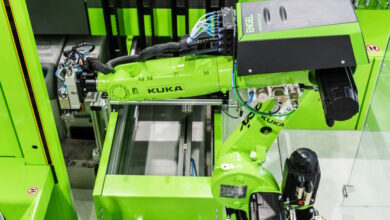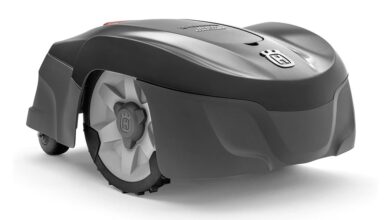Robots can use air to move objects • Earth.com

Scientists have an impressive new trick for robots: using the invisible force of air to manipulate objects. A recent study from Aalto University showcases a unique method of controlling objects from a distance. This technique has the potential to revolutionize how we think about robotics, manufacturing, and even everyday tasks.
Inspired by nature
The fundamental concept behind this innovation is quite simple. Air, although invisible, is a physical substance with the ability to exert force. This force can cause objects within its flow to move. The key challenge was understanding and controlling those movements.
Researchers achieved this by carefully studying the interaction between air currents and objects of various shapes and sizes. With this knowledge, they were able to develop techniques to direct and manipulate airflow in a way that allows for precise control over the movement of objects.
“Airflow or wind is everywhere in our living environment, moving around objects like pollen, pathogens, droplets, seeds and leaves. Wind has also been actively used in industry and in our everyday lives – for example, in leaf blowers to clean leaves. But so far, we can’t control the direction the leaves move – we can only blow them together into a pile,” said Professor Quan Zhou from Aalto University, who led the study.
Robots using air manipulation
To master the behavior of objects within an airflow, the scientists conducted a rigorous experimental phase. They exposed numerous objects to controlled air currents, meticulously recording their movements. This extensive dataset allowed them to identify relationships between the shape of an object and how it reacts to different airflow conditions.
Surprisingly, even within seemingly random airflow, the researchers discovered consistent patterns. These patterns became the building blocks for a control system capable of precisely directing airflow, enabling them to move objects in specific ways – even against the flow of the wind itself.
Robot’s air jet control algorithm
The unique algorithm at the center of this technology serves as the “brain” for the entire system. Its primary role is to calculate and execute the precise movements of the air jet nozzle to achieve the desired object manipulation. Here’s how it achieves this:
Input
The algorithm requires several pieces of information to work:
- Object characteristics: Data about the object’s shape, size, and possibly its material, derived from previous research on object-airflow interactions.
- Starting position: The object’s initial location on the surface.
- Desired path: The trajectory (straight, curved, complex shapes, etc.) along which the object needs to be moved.
Motors and nozzle control
The algorithm controls two motors that govern the air jet nozzle:
- Motor 1: Regulates the nozzle’s angle. Altering the angle changes the direction of the airflow hitting the object.
- Motor 2: Adjusts the nozzle’s position (e.g., closer to or farther from the object). This influences the force and concentration of the air jet.
Aiming the airflow
The algorithm strategically aims the air jet to manipulate the object. The nozzle’s positioning, along with the air pressure, dictates how the object will react within the airflow.
Real-time adjustments
Crucially, this process isn’t static. The algorithm continuously receives feedback on the object’s position. It compares this to the intended path and makes micro-adjustments to the nozzle’s angle and position. This dynamic control enables the object to be guided along even complex trajectories.
In summary, the algorithm acts as a tireless conductor. It analyzes object data, sets the initial nozzle position, and then orchestrates a series of continuous airflow changes to nudge the object along the desired path.
One of the most surprising findings involved the wide range of shapes the system could manipulate effectively. Our intuition might suggest that a formless force like airflow would have limited control over objects, especially complex ones. However, the researchers discovered a remarkable level of versatility in their technique.
Regardless of the object placed under the air jet, whether it was a precisely defined geometric shape or a completely crumpled piece of paper, the system could successfully guide its movement. This adaptability suggests a deeper understanding of airflow dynamics and object interaction than previously anticipated.
It opens doors for potential applications in scenarios where manipulating objects with traditional robotic grippers might be impractical due to their delicate or irregular shapes.
Robots, air flow and “ethereal fingers”
While the technology is still being perfected, its potential applications are vast and promising. Professor Zhou imagines robots equipped with this innovative system, replacing traditional physical grippers with what he describes as “ethereal fingers.”
These are essentially directed currents of air that can manipulate objects from a distance. This would be particularly useful for handling delicate items that cannot withstand direct contact, such as sensitive electronic components, which could be damaged by conventional mechanical touch.
In everyday scenarios, this technology could transform how machines operate in common environments. For example, robots could utilize this air manipulation technique to gather scattered debris, such as leaves or trash, or to sort objects based on size or type without ever physically touching them.
The range of potential applications is extensive, especially in situations where traditional physical interaction could be problematic or potentially damaging. This could include environments that are sensitive, hazardous, or where contamination needs to be minimized, showcasing the technology’s adaptability and utility in various fields and circumstances.
With additional research, the precision and efficiency of this contactless manipulation could skyrocket, opening up even more exciting applications for this natural, invisible force.
The study is published in the journal Advanced Intelligent Systems.
—–
Like what you read? Subscribe to our newsletter for engaging articles, exclusive content, and the latest updates.
Check us out on EarthSnap, a free app brought to you by Eric Ralls and Earth.com.
—–



